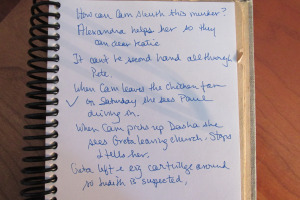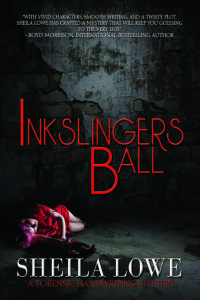Ask the Expert: Sheila Lowe
Edith, frantically trying not to drop any balls
We’re welcoming another expert to the blog today. I’ve known Sheila Lowe online  through Sisters in Crime for several years (we’re fellow Californians), and have read all but the latest in her smart, suspenseful Claudia Rose mysteries. One of my college roommates long, long ago studied handwriting analysis, and I’ve been fascinated by it ever since.
through Sisters in Crime for several years (we’re fellow Californians), and have read all but the latest in her smart, suspenseful Claudia Rose mysteries. One of my college roommates long, long ago studied handwriting analysis, and I’ve been fascinated by it ever since.
Like her fictional character Claudia Rose in the award-winning Forensic Handwriting Mysteries series, Sheila Lowe is a real-life forensic handwriting expert. She holds a Master of Science in psychology and is the author of the internationally acclaimed The Complete Idiot’s Guide to Handwriting Analysis and Handwriting of the Famous & Infamous, as well as the Handwriting Analyzer software. Her standalone novel of suspense, What She Saw, has nearly 200 five-star reviews. Sheila’s analyses of celebrity handwritings are often seen in the media.
Share your expertise with us, Sheila!
Name: Sheila Lowe
Area of Expertise: Court-qualified forensic handwriting examiner and handwriting analyst. This means I handle cases of handwriting authentication to determine possible forgery, and I also sometimes prepare behavioral profiles based on handwriting. The latter is used in areas such as pre-employment screening, mental health therapy, child custody issues, etc.
How did you become a handwriting expert?
We have to go back more than 45 years to answer that question. I first became interested as a senior in high school—1967. My boyfriend’s mother had read a book on handwriting analysis and she wrote two pages analyzing my handwriting, which I found completely fascinating—somebody understood me (very attractive to a 17 year-old girl)! I studied on my own for about ten years, then finally started taking courses with handwriting professionals. In 1981 I was certified by the American Handwriting Analysis Foundation (I’m currently the president), and in 1985 my testimony was first accepted in the court system as an expert witness.
What are 3 things we should know about your area of expertise?
Most handwriting analysts are not psychic. It’s not an inherited or inborn ability; it’s a learned skill.
“I should let you see my handwriting” is a common response when someone learns what I do. This is akin to meeting a doctor and immediately opening your mouth to say “Ahhhh.” Like any consulting business, this one should be taken seriously.
The biggest problem in my field is the lack of licensing in the U.S. Anyone can create a website and go into business with little or no training (and they do). I recommend that if you want your handwriting analyzed, you contact the American Handwriting Analysis Foundation and make sure the analyst you are interested in using has a good education and is professionally certified, with no ethics violations.
What do people usually get wrong when writing about handwriting analysts?

A page from Edith’s sprint journal (no, she didn’t ask Sheila what it meant!)
Some writers who don’t understand that handwriting analysis has a scientific basis treat it like crystal ball reading. Handwriting cannot predict the future, but is a lot like a picture of the writer’s psyche. It reveals he thinks, how he is socially and sexually, the state of his ego, and other aspects of personality. It’s not “woo woo” or magic. Interpretation of the spatial arrangement on the page, the writing style, and other aspects such as writing rhythm, speed, pressure, etc., paints an accurate personality portrait based on common sense. It’s not just about how you dot your i or cross your t. There are thousands of variables to consider in every handwriting.
Is there a great idea you’d love to share?
These days, public schools in most states are not required to teach handwriting. In fact, many of the younger teachers don’t know how to write in cursive. There are many reasons why it’s important for schools to keep cursive in the curriculum, not the least of which is brain development in young children. Current research indicates that, unlike hand printing or keyboarding, cursive writing helps kids to learn faster, remember more detailed information (written and spoken), and even spell better. My organization, AHAF, is looking for people to work with us in getting legislators to recognize and understand that while technology is important, so is handwriting: www.cursiveiscool.com
The fifth book in my series, Inkslingers Ball, was just released last July. I’ve just begun work on Unholy Writ, which involves ecoterrorism and geocaching, and will take my main character, Claudia Rose, to England.
Do you use your expert knowledge in your writing?
Yes. Claudia Rose’s practice mirrors my own. Readers say they learn something about handwriting analysis from my fiction (and hopefully, interested people will check out my nonfiction books, too). Claudia does not solve crimes using handwriting analysis—she’s not a PI. She uses her special knowledge to understand the people she’s dealing with, and also consults for the police department, sometimes with her lover, LAPD detective Joel Jovanic.
Readers: Questions for Sheila? Do you still write letters, and make sure your kids and grandkids know how to write cursive? Does this post give you ideas for writing characters?
Filed under: Ask the Expert Tagged: graphoanalysis, handwriting analysis, Inkslinger's ball, Sheila Lowe





